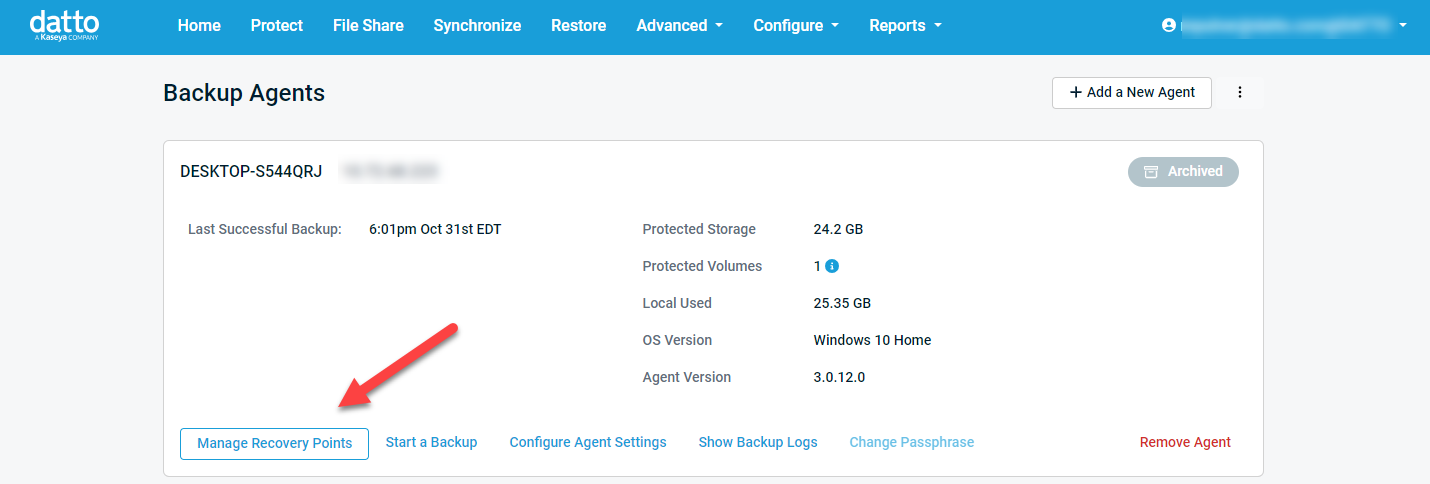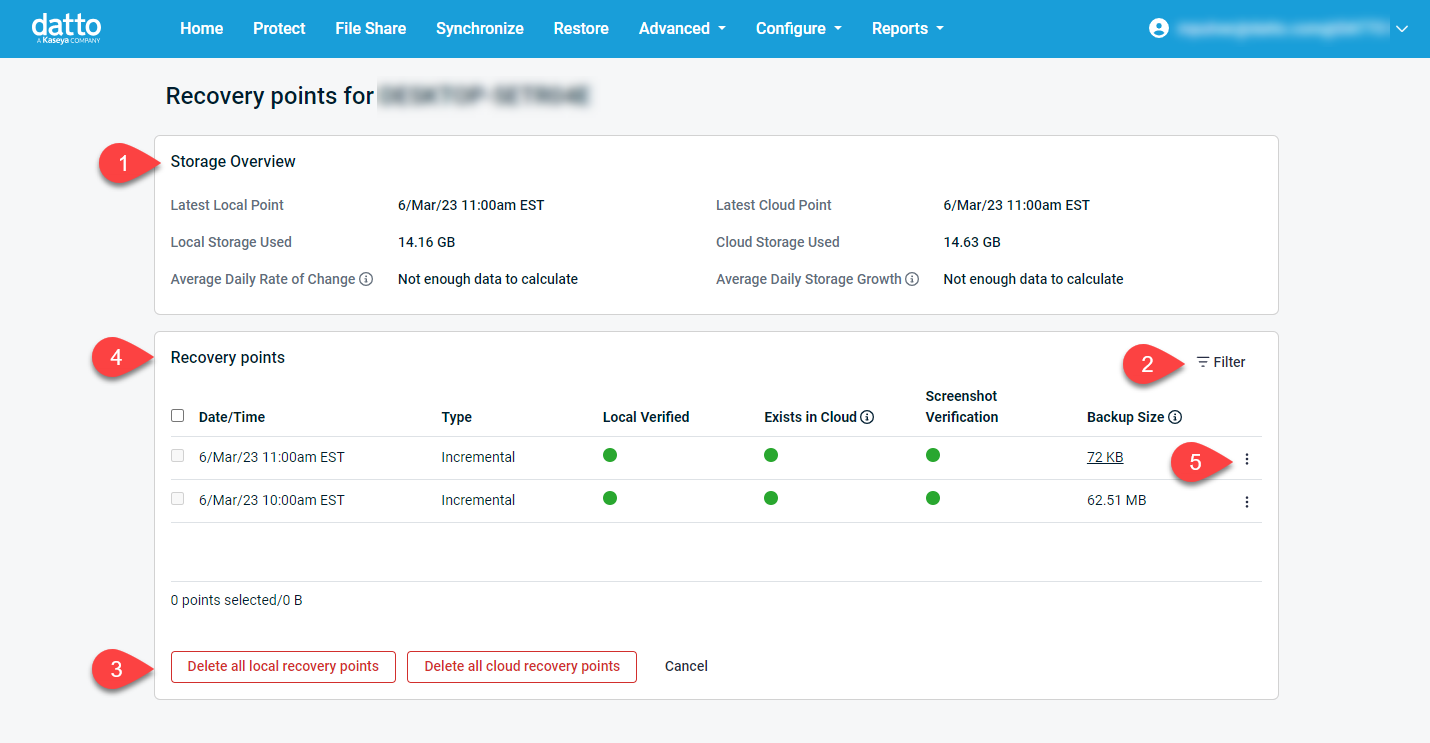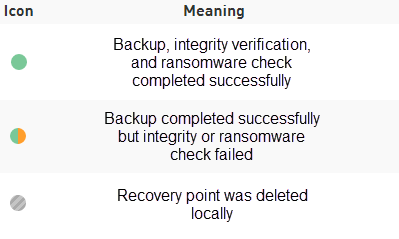Manage Recovery Points
This article describes the Manage Recovery Points page of the Datto appliance GUI.
Environment
- Datto SIRIS
- Datto ALTO
- Datto NAS
Description
The Manage Recovery Points page allows you to view critical information about the health of the backup snapshots for a protected system or share, and provides you with the ability to manage those snapshots.
Accessing the Manage Recovery Points Page
For enhanced security, certain features, such as the Delete all Cloud button, cannot be accessed locally, and are only available when accessing the Remote Web UI from the Partner Portal.
Log in to your Datto device's UI, either through the Partner portal or locally.
To access the Manage Recovery Points page for an agent pairing, select the Protect tab. To access the page for a share, select File Share.
Click the Manage Recovery Points link for the system or share that you would like to view.
Your Datto appliance will display the Recovery Points page for the selected system.
The Recovery Points page
The following information is presented on the Recovery Points page for the selected agent or share.
Storage Overview: This table displays the local and cloud storage information for the protected system. The information shown is:
- Latest Local Point: Displays the date and time of the most recent snapshot available for the selected system on your Datto appliance.
- Local Storage Used: Reports the total amount of local storage space used by the protected system's backups on the Datto appliance.
- Average Daily Rate of Change: Tracks the average amount of data that is added or modified daily on the protected system. A minimum of 10 days worth of backups for the protected system must be present on your Datto appliance for this field to display a value.
- Latest Cloud Point: Displays the date and time of the most recent snapshot available in the cloud for the selected system.
- Cloud Storage Used: Reports the total amount of cloud storage space used by the protected system's backups.
- Average Daily Storage Growth: Tracks the average daily growth of the local storage space used by the selected system's backups. A minimum of 10 days worth of backups for the protected system must be present on your Datto appliance for this field to display a value.
Page Filters: These toggles allow you to apply filters to show only local snapshots, only cloud snapshots, or just snapshots for which a screenshot exists.
Delete All Local and Delete All Cloud: Clicking either of these buttons will immediately delete all local backups or all cloud backups that are not required to maintain an association with the offsite backup chain for the selected system. See our article about Deleting Local and Cloud Data to learn more.
Recovery Points: This table allows you to view and manage the available snapshots for a protected system. The information shown is:
Date / Time: The date and time that the snapshot was taken. Clicking the checkbox next to one or more snapshots will display a summary of the local storage used by the point(s), and allow you to delete them via the Delete Local or Delete Cloud options. Learn more about the data deletion process in our Knowledge Base article on the subject.
NOTE You will not be able to select or mark any point for deletion that your Datto appliance has flagged for offsite replication or considers a Connecting Point - an essential snapshot that is used to maintain consistency between the local and offsite backup chains. To permanently remove all backup points for a selected system, you must first archive the backup chain.
Type: Indicates whether the snapshot taken was a Full backup (a full-disk snapshot of the production machine), Incremental backup (a snapshot of only that data which changed), or a Differential backup.
Local Verified: Provides an at-a-glance summary of the data integrity of the snapshot. See the Local Verified section of this article for more information. If the snapshot was deleted locally, but still exists in the cloud, the UI will indicate when the point was removed locally.
Exists in Cloud: Indicates if a local backup replicated to the Datto Cloud. A green circle means that a cloud snapshot exists for the backup point; an empty ring means that one does not. Clicking any empty circle in this column will allow you to replicate the selected snapshot to the cloud if a newer connecting point does not already exist.
Screenshot Verification: Provides an at-a-glance summary of the bootability of the snapshot. See the Screenshot Verification section of this article for more information.
This column will not appear for NAS shares
Backup Size: Displays a representation of the disk space used locally by the snapshot. This value may change over time depending on the amount of unique data included in the backup. This value does not necessarily represent the amount of data that was written to the disk in that snapshot, but barring a full backup taking place, this value represents the amount of space you will reclaim if you delete the recovery point.
Additional Actions: Invokes a menu that will allow you to re-run screenshot verification on any eligible backup point. You can also review the log output of any script validation tasks run during the verification process. These options are not available for NAS shares.
To ensure data integrity, and to allow you to make informed decisions about which snapshots to restore from in the event of a disaster, your Datto appliance will run the following validations during the backup process:
- Filesystem Check: Checks for critical filesystem errors in the snapshot which could affect its usability. If the snapshot fails the filesystem check, the reason for failure is reported by the Datto appliance. For more information about this feature, review our Advanced Backup Verification: Local Verified article.
- Volume Check: The Datto appliance will check that the volumes which were captured in the backup match the volumes included for backup in the Volume-Level Backup Control interface. If a volume is missing, the Datto appliance will alert you.
- VSS Check: If VSS writer failure occurred on the production machine during the backup process, causing the agent to fall back to the crash-consistent STC or DBD backup engine to capture a snapshot successfully, the failure will be captured and reported. This check will only occur if you have configured the agent to use a fallback engine.
- Ransomware Check: The Datto appliance will check the snapshot for signs of ransomware, and alert you if an infection is suspected. See the Ransomware Detection 101 article for more information.
The icons in the Local Verified column of the Manage Recovery Points page indicate the health of each snapshot:
Mousing over the icons in the Datto appliance interface will display a detailed backup report for each snapshot.
Your Datto appliance can perform automatic local virtualization, application, service, and script validation tests of each snapshot in a backup chain to evaluate their bootability in the event of a disaster. You can learn more about how this process works in the Introduction To Screenshot Verification, Application Verification, Service Verification, and Advanced Screenshot Verification - Script Validation articles.
NOTE Application Verification and Service Verification are disabled by default. You can enable these features on a global or per-system basis from the Configure Agent Settings page of the Datto appliance GUI.
The verification process will report the results of each verification test in the Screenshot Verification column of the Manage Recovery Points page:
Mousing over the icons in the Datto appliance interface will display a preview of each screenshot.
If a screenshot does not exist for a backup point, clicking the 'empty' icon will queue the point for verification testing. To re-run verification for a point, click the menu button (Additional Actions above), and click Re-Run Verification.
If a screenshot is underway, an estimated time to completion will replace the icon. The report will automatically refresh when the verification test has completed.
NOTE The selected system must have completed at least one backup, and the backup must exist on the local Datto appliance, for screenshot verification options to become available. Screenshot verification is not available for Datto NAS or systems protected by the Datto Mac Agent.







